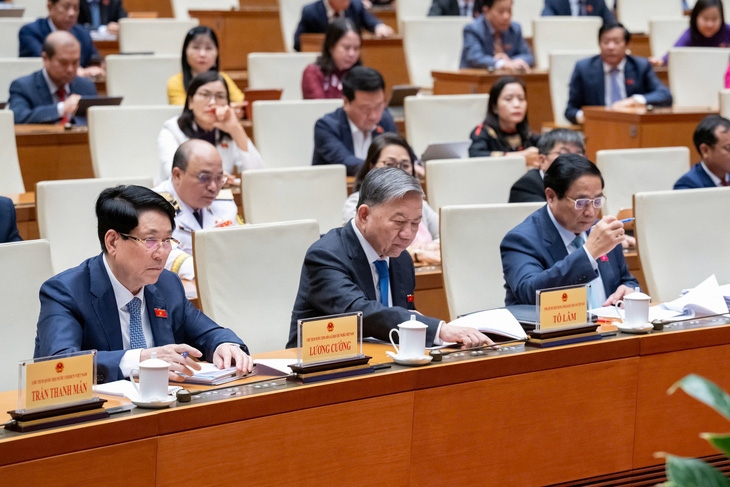The North-South high-speed railway project has a total length of about 1,541km, a design speed of 350km/h and a total investment of more than 67 billion USD.
Delegates participating in the meeting – Photo: GIA HAN
On the afternoon of November 30, with 443/454 delegates present in favor, 7 delegates disagreed, 4 delegates did not vote, the National Assembly passed a resolution on the investment policy of the high-speed railway project on the North-South axis.
High-speed rail has 23 passenger stations
Accordingly, the high-speed railway project has a total length of about 1,541km; the starting point is at Ngoc Hoi station (Hanoi), the end point is at Thu Thiem station (Ho Chi Minh City).
The North-South high-speed railway passes through 20 provinces and cities: Hanoi, Ha Nam, Nam Dinh, Ninh Binh, Thanh Hoa, Nghe An, Ha Tinh, Quang Binh, Quang Tri, Hue, Da Nang, Quang Nam, Quang Ngai, Binh Dinh, Phu Yen, Khanh Hoa, Ninh Thuan, Binh Thuan, Dong Nai, Ho Chi Minh City. HCM.
The National Assembly decided to invest in a new 1,435mm double-gauge road, with a design speed of 350km/h, a load of 22.5 tons/axle; 23 passenger stations, 5 cargo stations; means and equipment.
High-speed railway transports passengers, meets the requirements of dual-use for national defense and security, and can transport goods when necessary.
Preliminary total land use demand of the project is about 10,827ha. When implementing the project, it is expected that about 120,836 people will be resettled.
The North-South high-speed railway is invested in the form of public investment, with a total investment of more than 1,713 million billion VND (equivalent to more than 67 billion USD).
The National Assembly decided to make a feasibility study report from 2025, striving to basically complete the project in 2035.
Before the National Assembly voted, Chairman of the Economic Committee Vu Hong Thanh had an explanation report on the absorption of the draft resolution.
Accordingly, a number of opinions suggested a thorough assessment of financial efficiency, especially the ability to recover capital, the ability to return capital and the subsidy for the project during operation and exploitation.
Regarding this content, the Standing Committee of the National Assembly stated that the Government has calculated the direct and indirect economic benefits very large but cannot be calculated into the revenue and financial efficiency of the project.
Similar to the model of countries in the world, railway projects bring great efficiency to the economy, but the revenue calculated for the project is mainly from transportation revenues, commercial exploitation to balance the cost of operation and maintenance of vehicles, etc maintain infrastructure and pay infrastructure fees to the State.
Accordingly, in the first 4 years of operation, the revenue can only offset the cost of operation and maintenance of vehicles.
Therefore, the State needs to support part of the economic non-business capital allocated for the current railway system to maintain infrastructure.
Capital allocation through 3 medium-term periods
Many comments suggested supplementing a more complete assessment of capital sources and the ability to balance capital, allocate capital for each phase of the project to ensure feasibility and efficiency.
It is proposed to supplement a thorough assessment of the impact of project investment on the state budget deficit, public debt and the budget’s ability to repay debts in the medium and long term.
There is an opinion that the project goes through 3 medium-term periods, so the total investment approved in any period is only counted in that period, the capital to be implemented in any period is calculated in that medium-term period and should not be transferred from the previous medium-term period to the next medium-term period.
Regarding this content, the National Assembly Standing Committee clearly stated that the project lasts through 3 medium-term periods, the ability to balance capital, and allocate capital to implement the project.
Specifically, in the period of 2021 – 2025, the capital demand for the project is about VND 538 billion (used for investment preparation) has been balanced in the medium-term public investment plan of the Ministry of Transport.
In the period of 2026 – 2030, the capital demand is about VND 841,707 billion and in the period of 2031 – 2035, the capital demand is about VND 871,302 billion.
According to the Law on Public Investment 2019, currently assessing the ability to balance capital sources can only be implemented according to the 5-year medium-term public investment plan, the transition to the next stage is not more than 20% of the previous public investment plan.
The project lasts through 3 medium-term periods, so the determination of the ability to balance capital is not regulated. Therefore, the draft resolution stipulates that the project is allocated capital through the medium-term public investment plan periods.
The capital level allocated for each medium-term period is in line with the project implementation schedule and is not required to carry out the appraisal of the ability to balance capital in accordance with the Law on Public Investment.

